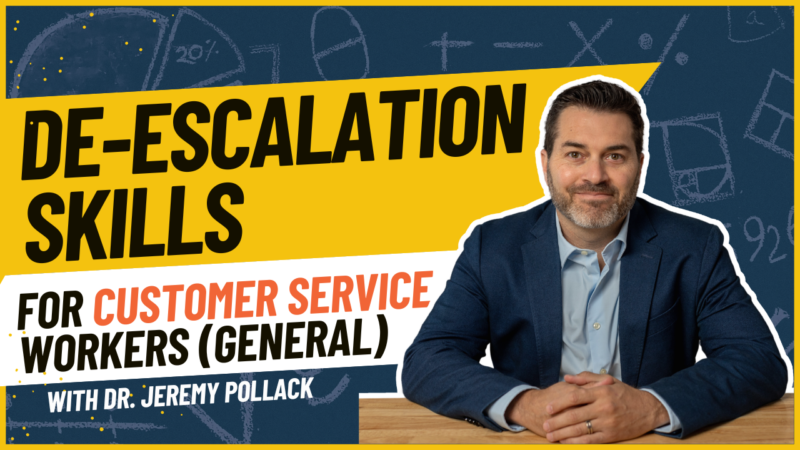Table of content
De-escalation can be defined as the art of calming a tense situation using strategic communication and behavior techniques. When a person challenges you, it’s crucial to respond in a way that lowers the potential for conflict rather than escalating the tension. Employing effective de-escalation techniques can be transformative across all industries, enhancing workplace safety and improving interpersonal dynamics.
In moments of confrontation, the ability to de-escalate effectively can turn a potentially volatile encounter into a manageable, even productive dialogue. One key approach is to offer concise and respectful choices to the individuals involved. This method empowers them to feel in control of the situation, thereby reducing the intensity of their emotional response and leading to a more peaceful resolution.
The Importance of De-Escalation Techniques in Diffusing Conflicts
In today’s fast-paced and often high-stress environments, mastering de-escalation techniques is essential. These strategies can significantly impact the outcome of confrontational situations, turning potential conflicts into opportunities for understanding and resolution.
Preventing the Escalation of Conflicts
One of the primary roles of de-escalation techniques is to prevent a situation from becoming more volatile. By understanding how to influence a person’s behavior positively, it’s possible to avoid the circumstances in which a situation escalates into something more serious or dangerous.
Safety for All Involved
Safety is a key concern in any conflict scenario. Effective de-escalation ensures that all parties involved can remain safe. This is particularly important in industries where workers face potentially aggressive or volatile individuals.
Improved Outcomes
When you respond to conflict by escalating, it often leads to negative outcomes. However, using de-escalation can lead to more constructive results. By calming the situation, you open the door to dialogue and problem-solving rather than confrontation.
Reduction in Stress and Anxiety
Conflicts can generate significant stress and anxiety for everyone involved. De-escalation techniques can help reduce these emotional responses by addressing the underlying feelings of the individuals involved, promoting a more rational and less emotionally charged environment.
Building Better Relationships
The ability to de-escalate conflicts is crucial in building and maintaining healthy interpersonal relationships, both in personal and professional settings. It shows empathy and respect for others’ perspectives and needs, fostering a more cooperative and harmonious environment.
Understanding the Psychology of Conflict and Aggression
The psychology behind conflict and aggression is complex, involving a wide range of emotional and cognitive dynamics that influence behavior. Understanding these elements is essential for addressing and resolving conflicts effectively.
Emotional Roots of Aggression
Aggression often stems from deep-seated emotional triggers. The root cause of aggression can be linked to feelings of threat, frustration, or injustice. When a person feels attacked or cornered, their immediate response can lead to aggressive behaviors. This emotional basis is crucial for understanding why conflicts escalate and how they might be mitigated before the situation escalates.
Cognitive Aspects of Aggression
Aggression is not solely an emotional response—it also involves cognitive processes. How individuals perceive and respond to a situation can lead to aggression. For example, if a person interprets a comment or action as intentionally harmful, they may react aggressively. The cognitive evaluation of threats is, therefore, a significant factor in conflict scenarios.
Sociocultural Influences
The environment and culture in which a person is raised can significantly influence their behavior during conflicts. Sociocultural norms dictate how emotions and aggression are expressed and managed. Understanding these influences can help identify why certain behaviors are more prevalent in specific contexts, which is vital for those involved in conflict resolution.
Biological Factors
Biological factors also play a role in aggression, including genetics, neurobiology, and physiological responses. For instance, the fight-or-flight response can trigger aggressive behavior when a person feels physically or emotionally threatened.
Impact of Aggression on Relationships
The impact of aggression extends beyond the immediate conflict. It can have long-lasting effects on relationships, whether personal or professional. For businesses and service providers, understanding the dynamics of aggression is a soft skill that can help maintain healthy interactions with clients and colleagues. By focusing on the underlying feelings and causes of aggression, professionals can better navigate and resolve conflicts.

De-Escalation Techniques for Defusing Conflict
Mastering de-escalation techniques is crucial for maintaining calm and constructive interactions, especially in high-stress situations. These techniques help in de-escalating conflicts by focusing on communication and behavior, which are essential in preventing situations from spiraling out of control.
1. Active Listening Skills to Enhance Communication
Active listening is a foundational skill in de-escalation. It involves more than just hearing words. It’s about listening with empathy and showing the speaker that they feel heard. This method can diffuse tension significantly.
Using the HEARD method—Hear, Empathize, Acknowledge, Respond, and Diagnose—helps ensure that the person feels valued and understood rather than dismissed. This approach encourages open dialogue and can prevent misunderstandings that might otherwise escalate.
It’s important to ignore challenging questions that can derail the conversation and focus instead on the underlying feelings of the person involved.
2. Non-verbal Cues and Body Language to Establish Rapport
Body language and nonverbal communication play a significant role in how messages are received during a conflict. Effective use of nonverbal cues, such as maintaining appropriate eye contact and keeping your body posture open, can foster trust and ease tensions.
Communicating nonverbally in a positive way shows that you are engaged and open to understanding the other person’s perspective. This form of communication can be especially powerful in calming an agitated individual and establishing a connection that facilitates more effective dialogue.
3. Effective Strategies for Calming Emotions and Managing Stress
Managing emotions in a high-stress situation is key to effective de-escalation. To remain calm, it’s important to manage your own reactions first. Ensuring you respect personal space and keep your body language neutral helps prevent further agitation.
Techniques like deep breathing and maintaining a calm demeanor can help both you and the other person relax, making it easier to engage in rational discussion. When faced with challenging questions, responding in a thoughtful and composed manner can help de-escalate the situation. Employing verbal de-escalation techniques also plays a crucial role in calming the environment.
4. Conflict Resolution Techniques to Reach Mutually Beneficial Solutions
Finally, finding a resolution that all parties can agree on requires careful negotiation and compromise. By understanding the other person’s feelings and behavior, you can better navigate the conversation toward a solution that respects everyone’s needs.
Asking open-ended questions that encourage discussion rather than simple yes or no answers can open up the dialogue for more creative solutions. This approach not only addresses the immediate conflict but also lays the groundwork for healthier interactions in the future.
Identifying and Addressing Underlying Issues Causing Escalation
Effectively managing conflicts involves understanding the deeper issues that fuel escalation. Some of the underlying issues that typically cause conflicts to escalate include:
Misunderstood Intentions and Perceptions
A common cause of conflict escalation is the misunderstanding of intentions or the incorrect perception of threats. This can happen when a person challenges you, interpreting your actions as hostile when they are not intended as such.
To address this, it’s essential to clarify intentions early and ensure transparent communication. Taking a few moments to explain your actions and listen to the other party’s concerns can prevent misinterpretations that lead to escalation.
Anxiety and Stress Responses
Another underlying issue is the person’s anxiety or stress, which can cause them to react defensively or aggressively. People often have trouble identifying their stress triggers, which can inadvertently escalate conflicts.
To manage this, create a supportive environment where individuals feel safe to express their anxieties. Techniques like ensuring adequate personal space and encouraging parties to remain calm can help mitigate stress-induced escalation.
Unresolved Historical Grievances
Long-standing unresolved issues or historical grievances can also lead to conflict escalation. These deep-rooted issues require a careful approach to uncover and address.
Facilitating discussions that allow all parties to express their feelings and experiences related to these grievances can help. It’s crucial to approach such conversations with sensitivity and a willingness to respond constructively.
Lack of Problem-Solving Skills
Finally, a lack of effective problem-solving skills can prevent conflicts from being resolved peacefully. When individuals aren’t equipped with the necessary tools to navigate disagreements constructively, minor disputes can quickly escalate.
Providing training in conflict resolution techniques, such as active listening and negotiation, empowers individuals to address and resolve conflicts before they escalate.

The Role of Empathy and Compassion in De-Escalation
Empathy and compassion are crucial in the process of de-escalation because they help in understanding and addressing the person’s feelings and experiences. These emotional tools are key in transforming potentially volatile situations into opportunities for connection and resolution.
Recognizing Emotional Experiences
When a person’s behavior seems aggressive, such as when getting yelled at, employing empathy involves recognizing the emotional underpinnings of their actions. For example, guessing at the person’s feelings and expressing understanding can significantly diffuse tension.
An effective phrase might be, “It sounds like you’re really overwhelmed by this situation,” which acknowledges their feelings without judgment.
Maintaining a Calm Presence
Compassion involves keeping one’s body language neutral and giving space, both physically and emotionally, to allow the individual to express oneself. This approach not only respects the person’s anxiety but also helps in trouble to identify the real issues behind their reactions.
Keeping your body language open and using phrases like, “I’m here to help, not to judge,” can set a tone of safety and understanding.
Offering Supportive Choices
Offer a person options that help them feel in control of the situation. This could be as simple as asking, “Would you like to sit down and talk this through, or would you prefer some time to yourself first?”
Such options respect their personal space and contribute to a supportive environment. This approach also helps to focus on constructive outcomes rather than the conflict itself.
Differences in De-Escalation Techniques in Various Scenarios
De-escalation techniques vary significantly across different industries due to the unique challenges and interactions specific to each field.
Customer Service
In customer service, the primary goal is to resolve conflicts with customers without escalating the situation. Techniques involve active listening and offering apologies or compensation to address the customer’s concerns.
For instance, a representative might use phrases like “Let’s see how we can fix this together,” aiming to offer concise and respectful choices and keep the interaction as positive as possible.
Discover our customized de-escalation training for customer service representatives.
Healthcare
De-escalation techniques are essential for healthcare professionals who deal with patients who may be agitated or distressed. Keeping body language neutral and offering a calm presence can help soothe patients.
Healthcare workers often need to take a few moments to understand a patient’s needs or pain points, which can be critical in preventing a situation from becoming volatile.
Discover our customized de-escalation training for healthcare professionals.
Law Enforcement
For law enforcement, de-escalation techniques focus on ensuring public safety while managing potentially dangerous situations. Officers are trained to maintain a calm demeanor, use non-threatening body language, and communicate clearly to avoid unnecessary altercations. They often have to make quick judgments about the person involved to de-escalate effectively without using force.
Discover our customized de-escalation training for law enforcement.
Benefits of De-Escalation Training
De-escalation training is essential across various industries, offering significant advantages that enhance both personal and professional environments:
Improves Safety
De-escalation training equips individuals with the skills necessary to manage conflicts safely, reducing the likelihood of violence and ensuring the well-being of everyone involved. This is particularly vital in roles such as security, where personnel frequently handle potentially volatile situations.
Enhances Communication Skills
Effective de-escalation involves active listening and empathetic communication, fostering better understanding and cooperation between parties. This training helps people manage difficult conversations more effectively, which is crucial in customer-facing roles and healthcare settings.
Reduces Stress
De-escalation training can help reduce stress levels by promoting more effective conflict management strategies. This not only improves individual well-being but also contributes to a more harmonious workplace atmosphere.
Builds Trust and Collaboration
When employees are trained in de-escalation, they are better able to foster trust and cooperation among their teams. This is because they are seen as capable and reliable in managing tense situations, which can enhance team dynamics and productivity.
Learn More About Our De-escalation Training
At Defuse, we offer tailored de-escalation training courses designed to enhance workplace safety and communication. Equip your team with the skills to handle conflicts effectively. Contact us today to learn more about our training solutions and start building a safer, more cooperative environment.




